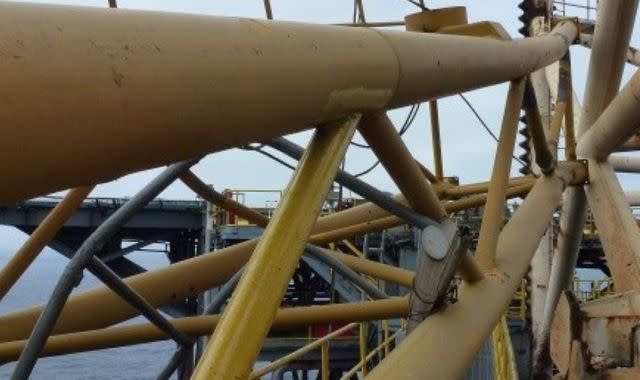Offshore drilling firm fined £130,000 over crane collapse on North Sea rig Rowan Gorilla VII

An offshore drilling company has been fined £130,000 over health and safety failings after a crane collapsed on a North Sea rig.
Inspectors from the Health and Safety Executive (HSE) described the incident as an "accident waiting to happen".
It occurred on the Rowan Gorilla VII in March 2016 as workers were preparing to recover a faulty submersible pump.
As the crane operator raised the boom to clear one of the three legs of the installation, it "failed catastrophically" and collapsed.
No one was injured, but the HSE said a "chaotic scene ensued" due to the flying debris.
Some of the sections fell into the sea between the rig and supply ship Solvik Supplier, which was pumping dry cement to the installation via a flexible hose.
The tip of the boom snagged the hose and dragged it under water. The hose then ruptured and whipped back onto the deck, engulfing the vessel in a cloud of cement dust.
The crane's auxiliary hook, cables, components, and rig debris also landed on the deck of the vessel.
Read more from Sky News:
Company hit with £100,000 fine over forklift incident
Mother suing building firm over son's manhole death at construction site
Following the incident, the HSE found that Rowan Drilling (UK) Ltd had failed to check that a limit switch - designed to prevent the crane boom from being raised to the point of mechanical failure - had been correctly set.
Joystick control safety mechanisms were also found to have been overridden which prevented them from returning to their locked neutral position.
HSE said five Rowan employees were on or around the crane at the time of the crash, and 13 crew were onboard Solvik Supplier.
Rowan Drilling (UK) Ltd pleaded guilty to health and safety failings and was fined £130,000 at Aberdeen Sheriff Court on Thursday.
HSE inspector Brian Kennedy said: "It was pure luck that nobody was seriously hurt or died as a result of these failings.
"As with so many incidents, the circumstances leading to the collapse of the port bow crane on the RGVII were years in the making and symptomatic of a defective safety management system that allowed those conditions to exist and persist.
"This was quite simply an accident waiting to happen and illustrates the vital importance of maintaining and testing crane limit switches to ensure they will always provide the intended level of protection."


